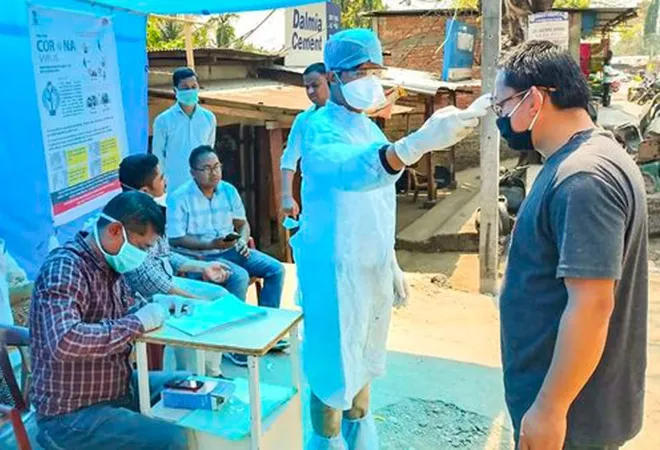
While the country is celebrating the “Kerala model” and the “Odisha model”—given the stellar fight put up by these states against COVID-19—there is another state situated in the north-eastern part of India that deserves credit for its handling of the pandemic. Assam serves as the gateway to the other six north-eastern states, while having a considerable population of 3.5 crores of its own. Owing to this fact, Assam could have easily succumbed to the pandemic, had it not been proactive in its preparedness and response towards the situation. The Assam government led by the Health Minister, Dr. Himanta Biswa Sarma and his team of sharp bureaucrats swung into action with just one mantra—“prepare, prepare and over-prepare”—and undertook the sole mission to minimise contingencies that could arise once the virus reached the state.
Government’s Responses
To put it in perspective, the state already had 3 testing centers, a 2000 bed facility situated in two stadiums, in addition to an existing 5000 beds, and each of Assam’s 33 districts had designated COVID-19 treatment centers even before the first case was detected on 31 March. Assam has come a long way since then, and the timely management and handling of the pandemic by the government has garnered recognition from all strata of the society.
In terms of efficient responses, the government of Assam was one of the first and only states to import 50,000 personal protection equipment (PPE) kits from China. Nearly 20 lakh people have been screened across Assam, of which nearly 188,000 have been screened in airports.
The government also directed schools to shut down from 15 March and not increase fees during the lockdown. In addition to this, the government also directed schools to pay the teaching and non-teaching staff without a pay cut. The state launched a local educational television channel called ‘Gyan Briksha’ for classes 1 to 12 to cover up the learning loss due to the lockdown. Further, the government evacuated 391 students from Kota, Rajasthan and brought them back into the state. These students went through mandatory quarantine of 14 days in government facilities. Similar rescue efforts were also carried out for students stranded across other states belonging to Assam.
On 27 April, the Chief Minister of the state announced an insurance cover of INR 50 lakhs to journalists based out of Assam. To support the folk artists and Lok Shilpis who are the soul of the state, the government has decided to provide each artist a sum of INR 2000 per month for the next three months.
For the returning migrant labourers, the Assam government has rolled out a number of measures catering to their needs. These include issuing job cards, giving free food rations for three months, increasing daily wage from INR 182 to 202 rupees under MGNREGA respectively. In addition to these measures, the government has further allocated 5 kg rice per monthto all the poor families who do not carry a ration card—a measure which will benefit 55 lakh house-holds.
Addressing the needs of patients across the state, the government also launched the “Dhanwantari Scheme” which ensured that the needy receive home delivery of locally unavailable medicines. The government further enforced strict criminal action through non-bailable warrants for violators of quarantine rules, as around INR 20,000 was incurred to quarantine each person arriving from outside the state.
The government did not shy away from maximizing the use of technology to help the state in its fight against COVID-19. Be it in terms of launching the mobile app “COVAAS” to spread information about COVID-19 or launching the “COVID Suraksha” app to monitor the status of home quarantined patients.
The government of Assam has deployed 1000 medical teams across the state to around 25,000 villages to screen patients for seasonal fever. The government further deployed Accredited Social Health Activists (ASHA) workers and multi-purpose workers (MPW) to monitor home quarantine patients. Quarantine wards of 1500 beds have been set up for police personnel along with 30 doctors and 200 nurses exclusively to treat any contingencies among the police personnel. In order to express gratitude to the frontline warriors of COVID-19, the government of Assam arranged the 14-day mandatory quarantine for all doctors and nurses at the Taj Vivanta, a 5-star hotel.
Outcomes
Since the centre eased the lockdown, there has been a sudden influx of people into the state amounting to a rise in the number of cases. Assam has been one of the few states which has dealt with this influx of migrants from in an astute manner. Mandatory 14-day institutional quarantine for everyone, be it a railway passenger or a person who has flown in, has been the strict instruction of the government to anyone who wishes to come back to Assam amidst this crisis. While most states like Delhi and Odisha prescribed home quarantine for air travellers, the Assam government was one of the first to come up with a notification clearly mentioning a 14-day institutional quarantine for air passengers. The government had an enormous task in terms of capacity building to accommodate such a huge influx of people, but nonetheless, it has managed to do so in a planned manner. The results of this are very interesting. First, of the 3319 cases detected as of today, nearly 98% of the cases are from the quarantine facilities. This figure tells us that the detection has been accurate, and that the government has tried its level best to contain the virus inside quarantine facilities and thus, avoided any imminent risk of community transmission. Secondly, another parameter that deserves due attention is the volume of testing that has been conducted in Assam. As of 21 June the number of samples tested across Assam amounted to 2,88,306 samples (Figure 1), which is quite high compared to similar resource laden states like Chhattisgarh, Jharkhand and Odisha. In tests per million count, Assam stands at 8407 tests per million with a percentage positive test rate of 1.83 percent. Third and most importantly, the mortality rate due to COVID-19 as of 21 June stands at 0.15 percent, which is 9 deaths in 5255 cases (Figure 2). Two major reasons leading to a low mortality rate could be efficient contact tracing leading to early detection of asymptomatic patients and the availability of enough beds to accommodate all suspected patients. This led to affected persons getting access to the right treatment from an early stage, eventually leading to large numbers of recoveries.
Figure 1: Covid19 tests conducted In Assam
 Source: https://en.wikipedia.org/wiki/COVID-19_pandemic_in_Assam
Source: https://en.wikipedia.org/wiki/COVID-19_pandemic_in_Assam
Figure 2: COVID-19 cases in Assam, India
 Source: https://en.wikipedia.org/wiki/COVID-19_pandemic_in_Assam
Source: https://en.wikipedia.org/wiki/COVID-19_pandemic_in_Assam
As we all fight the pandemic together, some states have done exceptionally well and Assam has given us enough reasons to be one of them. The comprehensive COVID-19 combat strategy of the Assam government primarily based on the 4 T’s—Trace, Test, Treat and Transparency—seems to have worked for the state. Effective contact tracing; rapid capacity building; scaling up testing infrastructure; treating COVID-19 patients with utmost care and precaution by utilizing both private and public healthcare infrastructure; and providing transparency in COVID-19 data has made the “Assam Model” effective, for now. In fact, the evaluation of the “Assam Model” does not seem to be completely wrong. There have been reports of a central team arriving in the state to study Assam’s COVID-19 management on 4 June. Since the fight against the pandemic is far from over, the knowledge of Assam’s approach to contain the virus might help other states, and can be an important source of reference with regards to their fight against COVID-19.
Lastly, though the article puts forth the “Assam model” as an effective way to combat COVID-19, it also embraces the fact that the Assam government can improve its own model by taking inspiration from other states on different fronts. For instance, the Kerala government’s work in collaboration with social groups and NGOs; the Jharkhand government’s driver and transport safety campaigns; and the Odisha government hospitals operating with 96 percent of compliance with all parameters—even in the midst this crisis—are lessons the Assam government can learn from and enhance its own model.
The views expressed above belong to the author(s). ORF research and analyses now available on Telegram! Click here to access our curated content — blogs, longforms and interviews.




 Source:
Source:  Source:
Source:  PREV
PREV


